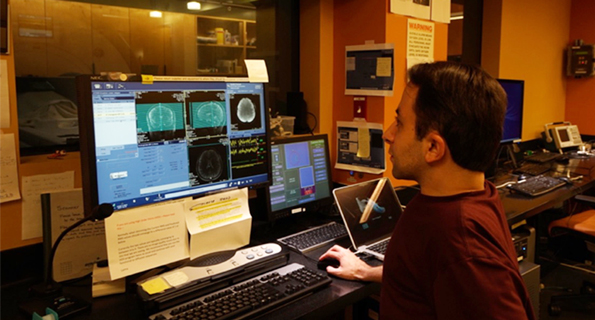April 2, 2019 — Growing up in California in the 1990s with a brittle bone disability, Nik Sawe appreciated every chance he got to go to Yosemite National Park. Spending time outside meant he was healthy, and that association helped touch off a lifelong love of nature.
That love led him to study biology in college, but breaking bones every few months due to seemingly minor injuries left him unable to do fieldwork. He shifted his focus from ecology to neuroscience and, after college, took a job in the medical device industry.
Reading research papers late at night, Sawe became interested in neuroeconomics, a field that explores our brain’s role in how we allocate scarce resources and weigh trade-offs between short- and long-term benefits. He saw that the questions neuroeconomics was asking could be applied to environmental issues. After reaching out to his old biology professors at Stanford, he ended up applying to an interdisciplinary environmental Ph.D. program with a proposal to use neuroeconomics to study how people make environmental decisions.
Today, as head of the Stanford Environmental Decision-Making and Neuroscience Lab, Sawe is at the forefront of understanding how various parts of the brain are involved in environmental decision-making — an emerging discipline with implications for everything from meat consumption to clean-air campaigns.
At the Intersection
Applying economic techniques to environmental questions isn’t a new strategy. Environmental economics, the study of the costs and benefits of environmental goods, came about in the 1960s, and really took off following the Exxon Valdez oil spill in 1989 when economists realized the need for methods of determining the value people place on something simply existing, whether or not they use it.
Since then, environmental economics has been used for things like assigning value to clean water as part of lawsuits and weighing the values of two different nonmarketable goods, such as reduced greenhouse gas emissions and reduced biodiversity due to using crop-based fuels, when developing environmental policies.
Sitting at the intersection of neuroscience, psychology and economics, neuroeconomics uses neuroscience techniques to study what’s happening physically in the brain when we do things like make decisions in uncertain circumstances.What is new is bringing neuroscience into the picture in the form of neuroeconomics.
Sitting at the intersection of neuroscience, psychology and economics, neuroeconomics uses neuroscience techniques to study what’s happening physically in the brain when we do things like make decisions in uncertain circumstances, try to avoid loss, and factor relationships and context into decisions.
Neuroeconomics research often involves giving people a series of surveys and tasks designed to determine the value they assign to different goods, then have them make decisions in an MRI scanner, which shows activity in various parts of the brain. This type of MRI scan is known as functional magnetic resonance imaging, or fMRI. Researchers then combine the fMRI data with the results from the economic surveys and tasks to discover what types of activity and what parts of the brain might be influencing their economic choices.
Iris Vilares, an assistant professor of psychology at the University of Minnesota, says neuroscience can add a lot to traditional economics research because it allows researchers to factor biology into decision-making theories and models.
“It helps to understand what are the biological and psychological limits that people have in terms of attention, or how people perceive things,” she says.
Neuroeconomics also provides the opportunity to observe stages of the decision-making process and interactions between different parts of the brain that suggest what types of information people are weighing when they make decisions. In contrast, behavioral methods only allow researchers access to what people report — their final conclusion and what they consciously considered to make it.

Environmental neuroeconomist Nik Sawe found that brain activity associated with disgust at imagined destruction is a better predictor of a person’s willingness to donate to protect iconic land than is brain activity associated with viewing photos of the land. Photo courtesy of Nik Sawe
Brain data also can be used to create a common currency for different types of value, such as moral value, the value of something simply existing, the value of something serving a public good and a monetary value. A local forest, for example, has monetary value due to the timber it contains, but also may have value from positive mental health effects on local residents, recreational opportunities and a geographic identity for neighbors. Brain activations that correlate with how valuable a person finds a good can be observed for all these categories, allowing more accurate comparisons.
Fundamentally Different
At Stanford, Sawe has used such methods to study how people decide to donate to protect publicly owned parkland from sale to private parties. He and colleague Brian Knutson found that a part of the brain’s reward pathway, the nucleus accumbens, increased activity when people saw a photo of public land that they consider iconic. Thinking about destructive uses of that land activated the anterior insula, a part of the brain associated with feelings of disgust, and this activity predicted whether the subject would donate part of the payment they received for participating in the study to save the park.
Sawe’s research indicates that there could be a unique negative feeling that enters into environmental decisions. Across the country, Paul Glimcher, professor of neural science, economics and psychology at New York University and the director of the NYU Institute for the Study of Decision Making, has used fMRI in conjunction with contingent valuation, a behavioral economics technique that asks how much someone is willing to pay for a good, to determine whether brain activity associated with assigning value to environmental goods is similar to brain activity associated with assigning value to snacks, consumer goods and everyday activities. His results suggested that there is something fundamentally different about how our brains make environmental valuations. But why?
Sawe’s research indicates that there could be a unique negative feeling that enters into environmental decisions. Sawe also suggests the possibility is that environmental decisions are just more complex than many other types of decisions, where pretty much everyone is trying to maximize their own gain.
“With environmental concerns, a lot of the time you’re weighing what it’s worth to you with what it’s worth more abstractly for the community or your values,” he says.
Potential Applications
Although environmental neuroeconomics is relatively new, what scientists have learned so far offers some insights into potential applications of this type of research. Environmental groups, for example, might use Sawe’s findings about parklands to preferentially use fundraising strategies that focus on threats to natural resources rather than on the rewarding aspects of using natural resources.
Sawe points to studies that have shown that fMRI can be used to predict what songs, movies and fundraising campaigns will be most financially successful at the national or international level. Observations of brain activity responses to environmental fundraising and promotional campaigns could help predict how well the campaigns will do in real life, allowing groups to boost the effectiveness of their messaging.

The planet’s most important stories — delivered to your inbox
Be the first to hear about important new environmental stories. Sign up now to receive our newsletter.
You have Successfully Subscribed!
Michael Livermore, an environmental law professor at the University of Virginia, says assessing the value people place on environmental goods is critical for these goods to be able to be a part of the political conversation and that neuroeconomics is a good way to do that. “If there’s not a way to actually place a value on environmental quality, it ends up being effectively zero,” he says.
Vilares sees environmental neuroeconomics as a valuable tool for developing evidence-based policies, such as policies aimed at maximizing the benefit of eco-labels (like Energy Star), and of determining the best ways to encourage lawmakers to decide to support those policies. The research coming out of both NYU and Stanford suggests that some people’s brains react to environmental questions very differently than other people’s do, sometimes using the same brain systems to a different degree or to different cues, and sometimes using entirely different circuits.
“Eventually we could technically connect [brain responses] with individual differences,” she says. “I’m really interested in looking at if there are different types of people for which different approaches [to getting support for environmental causes] will work better.”
Increased Interest
Blending psychology, neuroscience and economics allows researchers in the different fields to learn from each other to strengthen their own methods, encouraging neuroscientists to increase the number of participants they use and economists to adopt more experimental approaches.
Livermore sees difficulties for environmental neuroeconomics due to that interdisciplinarity, however. FMRI studies are expensive, and often neuroeconomics research falls outside the scope of funding agencies, making it difficult to get federal grant money. Finding collaborators can be tricky because neuroscientists may not be interested in heavily applied research, economists may not be interested in the biology of decisions and environmentalists may feel like economics is opposed to environmental values.
Despite this, Sawe has seen increased interest in his research. “In the last two years or so, I’ve gotten a lot more random groups reaching out wanting to do studies either for behavioral interventions or trying to understand how people are doing things like impact investing or philanthropy around environmental or sustainable issues,” he says. “It’s been a pretty sharp uptick, and as long as we’re able to keep showing that the brain data can be pretty powerfully predictive of what people are doing … it gives you insight into the approaches you should take.”
Editor’s note: Tori Espensen wrote this story as a participant in the Ensia Mentor Program. The mentor for the project was Jennifer Weeks. Ensia is partially funded by the University of Minnesota, which is mentioned in this story.
Related Posts
Ensia shares solutions-focused stories free of charge through our online magazine and partner media. That means audiences around the world have ready access to stories that can — and do — help them shape a better future. If you value our work, please show your support today.
Yes, I'll support Ensia!




To suggest that you can research the brain so you can gain financially is not new. We see all sorts of marketing to get me to do bad things for myself (eat bad food, drive a car)
I am immediately going to say this after reading the article, I will never give to an organization again. This is what I have done to products that use trickery to get me to buy more. Messing with my brain is off limits and is a sick endeavor. Ends do not justify the means.
All the more reason to turn off these computers and walk out into the woods.
It's interesting to see that this is still an area of interest - these studies have been conducted about 4-5 years ago. However, not much has happened since. Did you hear anything about ongoing research projects?
May I make a tiny suggestion? I didn't quite see an argument why neuroscientific techniques should be used rather than behavioral (psychologic) ones. This has been a permanent argument by critics, especially combined with the argument of it being costly. You can find some arguments in the works of Paul Glimcher and Ryan Webb.
To the previous commentators: Neuroeconomics is not about manipulating our brains - that would require techniques that are neither feasible (at least in the foreseeable future) nor likely to be permitted. The science helps us better understand and therefore predict decisions, an endeavour imminent to economics at least since Revealed Preference Theory (Samuelson, 1938). You might see this as a way to waste less resources. It's also akin (just more sophisticated) to the marketing techniques that deliver our social media content, which I presume most people enjoy.